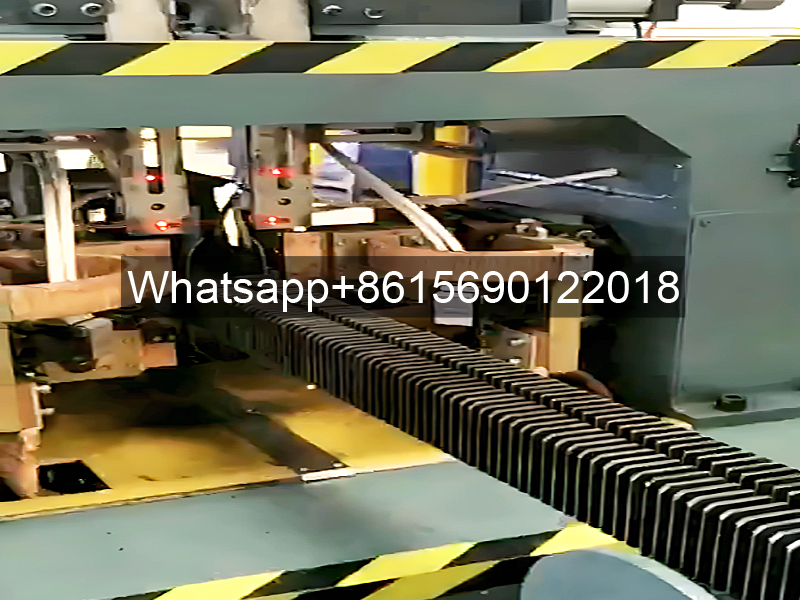H-type finned tubes are high-efficiency heat exchange elements widely used in industrial boilers, waste heat recovery systems, and chemical equipment. Their core structure consists of a base tube (usually a seamless steel pipe) and welded or rolled fins on the outside, significantly improving heat transfer efficiency by increasing surface area.
H-Type Finned Tube Manufacturing Process
High-frequency welding: High weld fusion rate, high tensile strength, and good thermal conductivity.
Material selection: Commonly used are ND steel, em aço inoxidável, or aluminized steel to withstand high pressure, high temperature, and corrosive environments.
The manufacturing process of H-type finned tubes mainly includes two core aspects: high-frequency welding and material selection. The production process can be further divided into the following steps:
I. H-Type Finned Tube Raw Material Selection and Pretreatment
Base tube material: Typically, low-carbon seamless steel pipes or welded steel pipes such as Q235 and Q345 are selected, with a diameter range of DN20-DN150 and a wall thickness of 2-5mm. Good thermal conductivity and mechanical strength are required.
Fin Material: Cold-rolled carbon steel strip (por exemplo,, 08Al, SPCC), thickness 0.3-1.5mm, width 10-50mm. Stainless steel or aluminum can also be used for special applications.
Pretreatment:
The base tube needs straightening (straightness ≤1mm/m) and sandblasting/acid pickling to remove rust (surface roughness Ra≥12.5μm).
The steel strip needs leveling (deviation ≤0.5mm/m) and annealing (600-650℃) to improve plasticity.
II. Core Process of High-Frequency Welding for H-Type Finned Tubes
Welding Principle: Utilizing the skin effect of high-frequency current (200-400kHz), the contact surface between the steel strip and the base tube is instantly heated to a molten state of 1200-1400℃, and then a forging pressure of 0.8-1.5MPa is applied to achieve metallurgical bonding.
H-type finned tube parameter control:
Power: 80-200kW (typical parameters for φ32mm tube are 120kW/15m/min).
Cooling: Atomized water cooling (5-8L/min) gradient cooling.
Quality inspection: Weld continuity must be inspected by X-ray or ultrasonic testing; tensile strength must be ≥90% of the base material strength.
III. Post-treatment and surface corrosion protection of H-type finned tubes
Stress relief: Tempering at 580-620℃ (≥30min) to relieve welding stress.
Surface treatment:
Hot-dip galvanizing (80-120μm thickness) or aluminizing treatment.
Stainless steel materials require passivation treatment.
Air tightness test: 3.5MPa water pressure holding test; leakage rate <0.01%.
Core Advantages of H-Type Finned Tubes
High Heat Transfer Efficiency: The heating area of H-type finned tubes is 7-8 times that of plain tubes and 2-3 times that of spiral finned tubes, effectively improving heat recovery.
Wear Resistance and Rigidity: Its rigidity is 3-5 times higher than a single-piece finned tube, offering excellent wear resistance and a long service life.
Reduced Dust Accumulation: The unique serrated structure and straight channel design ensure consistent airflow direction, reducing dust accumulation and facilitating cleaning with soot blowers.
Significant Energy Saving: For example, after a power plant upgraded its system, the flue gas temperature dropped from 180℃ to 120℃, and coal consumption per ton of steam decreased from 135kg to 98kg, resulting in considerable annual cost savings.
Application Scenarios of H-Type Finned Tubes:
Industrial Boilers: Used in economizers, superheaters, and other critical components, reducing equipment size and energy consumption.
Recuperação de calor residual: In flue gas coolers, the flue gas temperature can be reduced from 150℃ to 120℃ or lower, fully absorbing waste heat.
Chemical and metallurgical applications: High temperature resistant (up to 600℃ and above), corrosion resistant, suitable for complex industrial environments.
Welded H Type Boiler Finned Tube Welding Machine Manufacturer and Suppliers in China Factory

 dtfinnedtube.com
dtfinnedtube.com

